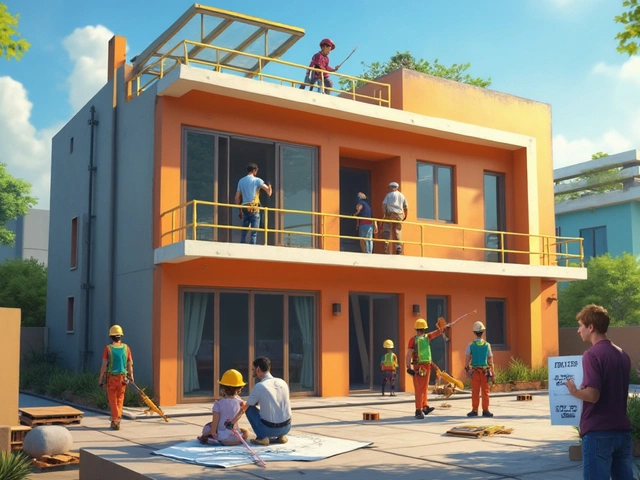Renovating a house can be both exciting and daunting. If you don't know where to start, it often feels like wading through a sea of paint swatches and flooring samples without a clear path. It's crucial to organize the renovation process smartly, ensuring each step builds upon the last effectively. A well-planned renovation can save money, reduce stress, and, ultimately, result in a more beautiful home.
Whether tackling major structural changes or simply revamping a room, every project thrives on strategic planning. Let's dive into the steps that will guide you through the transformation, making sure no stone is unturned - or no unexpected pipe burst, as life sometimes has a funny way of surprising you during these processes!
- Planning and Budgeting
- Structural and Demolition Work
- Plumbing and Electrical
- Walls, Floors, and Doors
- Kitchen and Bathroom Installations
- Final Touches and Decor
Planning and Budgeting
Embarking on a home renovation journey begins with meticulous planning and budgeting, laying down a roadmap for a successful project. The first step here is to identify the objectives of your renovation. Are you aiming for a complete remodel or just a few updates to refresh the space? The scope has a direct impact on the cost and time involved, so it’s crucial to be clear about your priorities from the outset. A key part of planning involves doing a comprehensive assessment of your home to identify areas that need attention. This not only includes cosmetic changes but also structural adjustments and system updates, such as plumbing or electrical work. During this stage, you may want to consult an architect or interior designer, especially for larger projects, to ensure your vision is feasible and to gain insights into potential design solutions.
The importance of budgeting cannot be overstated. Creating a detailed budget helps keep expenses in check, avoiding the all-too-common trap of overspending. Start by listing all anticipated expenses, including materials, labor, permits, and unexpected costs, often ranging from 10% to 20% of the total budget, which many overlook but are inevitable. To ensure accuracy, obtain multiple quotes for materials and services, comparing these against market standards. Tracking real-time expenses against your budget is vital; tools like budgeting apps or spreadsheets can aid in this endeavor. With statistics from a 2022 home improvement survey showing that nearly 30% of projects exceeded their budget by about 20% or more, staying vigilant on spending is essential.
Consider Permits and Inspections
Another key aspect of successful planning involves understanding the legalities tied to renovation work. Certain projects, particularly those involving structural changes or electrical and plumbing installations, may require permits from local authorities. Ignoring this can result in hefty fines or the need to undo work. Check with local councils about necessary permits and factor in this time and expense into your budget. Occupancy safety is also a focus, so don’t skip inspections which can prevent potential issues down the line. During planning, also ponder on the timeline for your renovation. This involves not only considering how long each phase might take but also factoring in potential delays—for instance, due to weather if any exterior work is involved. Setting a realistic timeline and being flexible to adjust is key, as rushing projects can lead to shoddy results or omitted steps.
"Failing to plan is planning to fail." — Alan Lakein
It's also worth investing in quality rather than cutting corners to save money in the short term. Higher-quality materials might have a higher upfront cost but often result in longer-lasting and better-looking results. Whether it's sturdy flooring, durable fixtures, or energy-efficient appliances, consider these long-term investment pieces carefully. This doesn't mean you need to splurge on every aspect, but rather smartly determine where your money will offer the best return in terms of durability and value.
| Aspect | Budget Consideration |
|---|---|
| Materials | 30-40% of total budget |
| Labor | 20-30% of total budget |
| Permits and Fees | 10-15% of total budget |
| Contingency | 10-20% of total budget |
Remember that successful planning and budgeting set the stage for all the phases that follow in your remodeling adventure. Whether it’s a minor update or a grand remodel, approaching it with a well-thought-out plan ensures that the renovation will be efficient and, more importantly, enjoyable.
Structural and Demolition Work
Embarking on the architectural heart of any renovation, the structural and demolition phase, is truly where the magic begins. It's this particular phase that lays the foundation for your vision, both literally and figuratively. This part of the process requires careful attention to ensure safety, functionality, and the seamless integration of all elements to come. At this stage, you'll want to engage in structural assessments to determine the overall condition of the property's bones, which may necessitate some unexpected yet necessary interventions.
The demolition step is often cathartic; it's a clean slate waiting to be reimagined. But beware of diving in without a strategic plan. Striking a delicate balance, you need to safely remove what's old and no longer needed, while protecting anything that remains integral to the new design. For example, maintaining structural integrity can be a labyrinth in itself. Factors like load-bearing walls must be identified and preserved or replaced with appropriate supportive structures. This is where the joys of engineering meet the creative spark of design.
"The most important thing about demolition is doing it methodically and with great precision,” says renowned architect Sarah Susanka. “It's not just about tearing things down, but preserving what matters and laying a strong foundation for what's to come."
Engaging professionals during this phase is often crucial. They possess the expertise to safely perform the necessary tasks and to handle any surprises lurking behind those old drywall panels. From asbestos abatement to ensuring seismic stability, especially in areas prone to earthquakes, attention to every detail ensures the dream remains firmly planted in reality. To drive this point home, consider that according to the New Zealand Building Code, all structural work must comply with their rigorous standards to ensure both safety and sustainability.
During the renovation, addressing plumbing and electrical systems as part of structural alterations is likewise imperative. It's wise to conduct these updates now, preventing future headaches down the line. As you plan, remember that careful timing and proper sequencing ensure optimal installation and safe practice. Once structure and demolition are complete, the canvas is set, allowing decorators, finishers, and artisans to shine. To practitioners and novices alike, let this stage be the symphony's harmonious overture, setting the stage for the crescendo of creative expression that follows.

Plumbing and Electrical
Tackling the plumbing and electrical aspects of renovation is essential to ensuring that your home functions efficiently and complies with safety standards. Whether you're dreaming of a luxurious spa-like bathroom or need to revamp the wiring for modern appliances, the importance of these systems cannot be overstated. It's the behind-the-scenes work that truly powers and supports the daily comforts of our lives. Initiating this stage at the right time is crucial, avoiding the dreadful situation of demolishing completed walls to fix unforeseen issues.
Engaging a licensed professional for these tasks is imperative, not only for the assurance of safety and compliance but also because it often requires a specific set of skills and knowledge. Many homeowners overlook the necessity of a solid upgrade in this department, especially when moving into an older home. As Jim Graham, a seasoned contractor, says,
"Never underestimate the chaos an outdated system can bring to your meticulous plans. Water and electricity can become silent saboteurs if not handled with foresight."
While embarking on this phase, start by assessing your current systems. Make a detailed list of desired changes, be it updating old pipes to avoid leaks or rewiring for additional outlets that today's tech demands. Cost estimation is another aspect where expertise can offer invaluable insight, ensuring that your budget does not balloon unexpectedly. Knowledge of local codes and regulations, which professionals command, is also paramount; compliance is not just legal necessity but assurance that systems operate safely.
If you’re remodeling a kitchen or bathroom, mapping out the specific locations for sinks, dishwashers, showers, and power outlets is crucial during the renovation planning. Install these systems before laying down walls and floors, making sure they align perfectly with your design's aesthetic and functional aims. In newer homes, you might find opportunities to integrate energy-efficient options such as low-flow taps and LED lighting that save on utilities and deliver an eco-friendly footprint. For those considering smart home advancements, this is the stage to factor in components like automated lighting systems or integrated water sensors.
An illustrative example of how much these systems can vary was highlighted in a 2022 study. The study revealed that homeowners investing in brand-new houses versus those renovating could potentially face an additional 15-25% surge in home renovation costs due to outdated or inefficient systems. The data further emphasizes the necessity of an up-front evaluation by a seasoned professional to consider complexities unique to each home.
Walls, Floors, and Doors
When it comes to home renovation, the elements of walls, floors, and doors serve as foundational aspects that can significantly impact the outcome, both structurally and aesthetically. The transformation of these elements often brings the most visible changes, serving as the canvas and framework for your home’s personality. Picking the right materials, colors, and styles is critical to ensure the renovation uniquely reflects your taste. Walls are not just barriers, they create the ambiance within spaces. From a fresh coat of paint to intricate wallpaper patterns or creative wall tiling, whatever you choose must resonate with the mood you wish to achieve in each room. It's like a piece of a larger puzzle; selecting the hues or designs should harmonize with the rest of your home’s theme.
Flooring choices affect both comfort and durability, often feeding off the energy created by the walls. Whether you go for the warmth of hardwood, the luxury of stone, or the practicality of vinyl, think about how each room is used and what flooring can withstand. High-traffic areas might demand sturdier materials, while bedrooms might benefit from the coziness of carpet. Interestingly, according to a National Association of Realtors report, hardwood floors have seen an increase in value of around 3-5% in home resale value.
Doors serve both functional and decorative roles; they frame perspectives and create transitions between spaces. Opting for solid core doors can significantly enhance soundproofing among rooms, thereby adding to privacy, while glass-paneled doors can keep spaces connected yet distinct. Door handles, hinges, and trims further add to these settings, small details that speak volumes, often subtly tying together the larger design narrative of your home renovation project.
Many seasoned builders will advise considering these three together; they indeed need to harmonize to elevate the space into a coherent whole. As Frank Lloyd Wright once wisely said,
“The longer I live, the more beautiful life becomes. If you foolishly ignore beauty, you will soon find yourself without it. Your life will be impoverished. But if you invest in beauty, it will remain with you all the days of your life.”
The interplay of texture and color found in walls, the grounding feel of the floors beneath, and the transitional roles doors offer create a symphony within homes. An efficient reno should comprehend these as a seamless flow, where each aspect complements and contrasts with the others, offering functionality while appealing aesthetically. A tip: Ensure to lay down protective coverings and plan work schedules to prevent damage and mis steps during other high-impact renovations. The goal is an environment that doesn’t just look renovated but feels cohesively composed and lived-in.

Kitchen and Bathroom Installations
When it comes to home renovation, the kitchen and bathroom installations are the crown jewels that not only enhance a property's value but also the everyday functionality and user experience. Tackling these areas requires careful planning, a pinch of creativity, and a dash of practicality. Both spaces are often the most utilized in a home and need to be treated with the respect they deserve. Starting with a robust layout is paramount. The kitchen, often called the heart of the home, must be designed not only for visual appeal but also efficiency. Similarly, bathrooms, which are no longer just utilitarian spaces but mini havens, need to be planned to maximize every square inch for comfort and aesthetics. Before you even begin installations, it's crucial to coordinate the schedules of any plumbers and electricians, as these two trades often need to intertwill their work.
One of the first steps in your renovation journey should be deciding on a style or theme. Whether you're going for a modern minimalist look or a rustic farmhouse vibe, your choice will dictate everything from the type of countertops and cabinetry to the color of your fixtures and tiles. Using high-quality materials in these areas is crucial, as kitchens and bathrooms face heavy daily wear and tear. Investing in durable countertops like quartz or granite, and opting for stainless steel appliances in the kitchen, will not only ensure longevity but add a touch of class. In the bathroom, consider moisture-resistant materials such as porcelain tiles for floors and walls, which can stand up to years of splashes and humidity. According to a report from Remodeling Magazine's Cost vs. Value Report, homeowners can recoup about 55-65% of their kitchen remodel costs when selling, making it a wise investment.
When it comes to the installations themselves, it's essential that they are performed by professionals. While DIY projects can be satisfying and may save upfront costs, the expertise of professionals ensures a level of precision and adherence to safety standards that's hard to match. Importantly, professional installation can also prevent future headaches caused by leaks or faulty wiring. Aim to include ample storage in both spaces, as it's a key aspect that prospective buyers and users alike consider. Deep pantry cabinets, overhead storage, and pull-out drawers can transform a cluttered kitchen into an organized delight. Similarly, appropriate shelving and recessed cabinets in the bathroom can enhance the room's functionality without sacrificing style. As interior designer Nate Berkus aptly says, "Measure twice, cut once, and always hire a good plumber."
Additionally, lighting plays a significant role in both the kitchen and the bathroom and should not be underestimated. In the kitchen, a mix of task lighting under cabinets and ambient lighting above the work areas helps in effortlessly transitioning the space from task-oriented to family gathering hub. Bathrooms benefit from layered lighting, with vanity lights providing the right illumination for grooming, and sconces or overhead lights creating a relaxing atmosphere. Especially in bathrooms, consider natural lighting where possible, as it makes the space feel more inviting and expansive. To emphasize eco-friendliness, many homeowners now choose LED lighting solutions, which not only reduce energy consumption but also reduce greenhouse gas emissions. As per a study by the Department of Energy, LEDs use at least 75% less energy and last up to 25 times longer than incandescent lighting.
Keep in mind the intricacies involved with plumbing and ventilation systems during the kitchen and bathroom installations. These components serve a more fundamental role than simply facilitating daily routines. They ensure that no unpleasantries detract from the beauty and function of these spaces. Ensuring proper vent placement and seamless tap and sink fittings can prevent moisture build-up and molds. A modern approach includes touchless faucets and low-flow toilets, which can significantly cut down on water usage, a feature that increasingly matters to environmentally-conscious individuals. Transitioning these classic installation tasks into the 21st century involves marrying practicality with technological advancement, a trend observed in many contemporary home improvement endeavors. The key takeaway is that while aesthetics delight, functionality survives and solutions that accommodate modern habits should top the list of priorities for renovation goals.
Final Touches and Decor
The final touches in your home renovation journey often make the largest impact, completing the transformation from a mere construction site to a welcoming abode. At this stage, it's all about adding character and personality to the spaces that have been meticulously pieced together. While the days of hauling drywall and managing electrical systems are now behind you, the decisions in decor and styling can be just as crucial. Selecting the right combinations, updating inventory, and ensuring cohesiveness throughout your home is no small feat.
It's a known fact that color schemes can significantly influence how a room feels. Typically, lighter tones tend to create openness and airiness, while darker shades deliver a sense of coziness and intimacy. Benjamin Moore, a prominent paint company, suggests creating an accent wall to add dimension and focus to a room without overwhelming it with bold hues. When painting, think about where natural light hits a room and how reflections might play a role in creating ambiance. Rugs, curtains, and cushions also come into play here to tie everything together. As such, choosing the fabric, texture, and pattern for these items is key to complementing, rather than clashing with, the room's overall feel.
"Design is not just what it looks like and feels like. Design is how it works." – Steve Jobs
Lighting is another crucial aspect often overlooked in the finalization of home renovations. Beyond aesthetic charm, lighting also influences functionality. Consider layering lighting elements: ambient lighting for overall illumination, task lighting where specific activities will be performed, and accent lighting to highlight architectural features or artworks. Chandeliers, pendants, and dimmers become tools to sculpt how each room breathes new life. According to trusted design anecdotes, placing a mirror opposite a window can enhance natural light's impact, an old trick that is both practical and delightful.
As for art and decorative pieces, they serve both as a medium for self-expression and as an avenue to polish the home's appearance. Sprinkling personalized decor items like family photos or unique travel finds provides a narrative thread throughout your house, creating a sense of belonging. It's essential to aim for a balance; items should feel curated rather than cluttered. A simple gallery wall or a statement sculpture can often become conversation starters, seamlessly blending utility with style.
Before moving on from renovations, take a moment to review the completed work. Small tasks such as touch-up painting, fixing any minor issues that might have gone unnoticed, and even a final deep clean should be on your checklist. A little extra polish in these areas can elevate the entire project, leaving you with an irresistible sheen of accomplishment. With every shade of paint, fabric texture, and art piece thoughtfully chosen, each room amalgamates style with a personal touch, sustaining its own unique charm while fitting within your home's broader narrative.



Write a comment